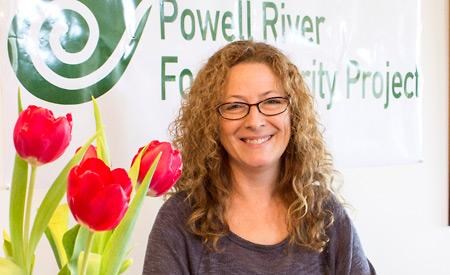Food security is something that can be seen through a variety of lenses. For business people, it looks like the maintenance of supply chains, to local government it is agriculture and land use planning, to consumers it is through the price of fresh produce and wondering about what the term organic really means. It is a complex issue that sparks conversations and debate in Canada and around the world.
“It is really about how we get food from farm to table in a way that is sustainable and workable for all of us,” said Vanessa Sparrow, coordinator of Powell River Food Security Project. “It’s no small thing, but it is not as mysterious as it sounds.”
It is a challenge that is increasingly being addressed by communities, including those small and remote.
“Food insecurity is a problem, but it is something that happens within a system,” said Sparrow, who has experience teaching food literacy in schools and to vulnerable people in the community.
One of the most essential determinants of health is the food people eat. At a bare minimum people need to eat enough to not starve, but they also need to eat the right kinds of food for proper nutrition. Starvation and severe malnutrition may be uncommon in Canada, but the country is not immune to either.
According to Statistics Canada, in 2011/12 one in 12 households in the country experienced some food insecurity, with one in 40 households experiencing severe food insecurity. And almost one in 20 households with children experienced food insecurity with it being much more severe for some single-parent households.
Severe food insecurity can result in, Statistics Canada said, “reduced food intake and disrupted eating patterns.” The organization recognized that food insecurity is associated with a range of poor physical and mental health outcomes. A 2013 report on food security from the Conference Board of Canada noted that malnourished children are “less able to concentrate and perform at school, thus threatening their opportunity to gain an education and vital skills for life.” The long-term impacts on health and social well-being are large and well recognized.
Over the next seven months Sparrow will be embarking, with the help of a working group, on a project that will bring a variety of perspectives together to create a high-level picture of Powell River’s food system with a set of recommendations on potential actions.
“I’m not proposing that by doing this is going to make Powell River a food secure place,” Sparrow said, adding that over the past year of her job she has been asked about how severe the food insecurity is in Powell River. “Everyone will tell you there’s plenty of it, but that’s as specific as it’s going to get.”
Sparrow’s program, already funded by Vancouver Coastal Health for 10 hours per week, was eligible for additional funds which she thought could be used to help her achieve her goal of working with local governments around developing a food charter for the region.
Though food insecurity is a problem that needs addressing, the assessment takes a broader approach to identify what Powell River’s assets are as well as some areas which are in need of improvement.
She explained that the first step in developing food policy is performing an audit and assessment of the current food system, data which could act as a baseline for comparison. But with only limited financial and time resources, undertaking the job was not possible previously.
“It’s a seven-month project that will actually involve working with, as much as possible, a comprehensive range of representatives from the food system to look into the whole system and how components affect each other,” she said.
The project spans from February to August and will happen in stages. Sparrow will first establish key partners and project scope then go into the actually environmental scan and look at how social, economic and environmental factors in the community influence food security. She will also be identifying community assets with interviews, looking for gaps and working with stakeholders to create community priorities. She plans on producing maps of spacial data to help make the relationship of factors easier to interpret.
Sparrow hopes to have community engagement and the support and interest of local governments. “There’s no point in having an action plan if there is not investment from the people who can make it work. Understanding how the system works is one way of making sure that people get the food they need with prices they can afford in ways that are environmentally sustainable.”



